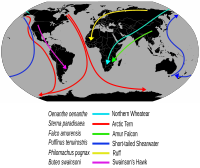
Photo from wikipedia
Moult of feathers entails considerable physiological and energetic costs to an avian organism. Even under favourable feeding conditions, endogenous body stores and energy reserves of moulting birds are usually severely… Click to show full abstract
Moult of feathers entails considerable physiological and energetic costs to an avian organism. Even under favourable feeding conditions, endogenous body stores and energy reserves of moulting birds are usually severely depleted. Thus, most species of birds separate moult from other energy-demanding activities, such as migration or reproduction. Common snipe Gallinago gallinago is an exception, as during the first autumn migration many young snipe initiate the post-juvenile moult, which includes replacement of body feathers, lesser and median wing coverts, tertials, and rectrices. Here, we evaluated moult-related changes in blood plasma biochemistry of the common snipe during a period of serious trade-off in energy allocation between moult and migration. For this purpose, concentrations of basic metabolites in plasma were evaluated in more than 500 young snipe migrating through Central Europe. We found significant changes in the plasma concentrations of total protein, triglyceride and glucose over the course of moult, while the concentrations of uric acid and albumin did not change. Total protein concentration increased significantly in the initial stage of moult, probably as a result of increased production of keratin, but it decreased to the pre-moult level at the advanced stage of moult. Plasma triglyceride concentration decreased during the period of tertial and rectrice moult, which reflected depletion of endogenous fat reserves. By contrast, glucose concentration increased steadily during the course of moult, which could be caused by increased catabolism of triglycerides (via gluconeogenesis) or, alternatively, due to increased glucocorticoids as a stress response. Our results suggest that physiological changes associated with moult may be considered important determinants of the low pace of migration typical of the common snipe.
Journal Title: PeerJ
Year Published: 2017
Link to full text (if available)
Share on Social Media: Sign Up to like & get
recommendations!